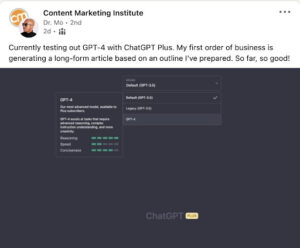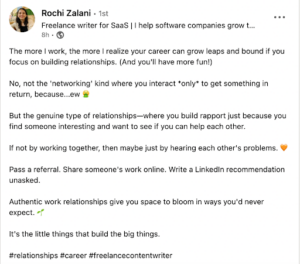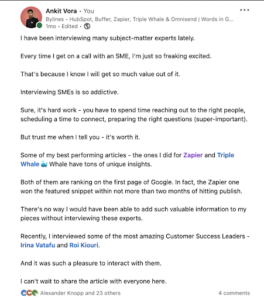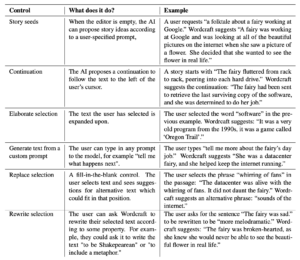During the summer of 2020, I worked for a content marketing agency that presented me with a disheartening message regarding AI in writing.
‘We are introducing an AI tool for writing blogs. Freelance writers are encouraged to learn to operate the tool or deliver 20 blogs daily to match the tool’s capacity. We will be compensated $150 per month for the work.’
At first, I thought it was a joke. Replace writers with an AI tool? How ridiculous. But then it hit me — they were serious. The situation left me disillusioned, and I quit working with them, as any writer with self-respect would.
Fast forward to 2023, and it’s clear that AI is progressing rapidly.

People are using ChatGPT to generate full blog posts from outlines, write their social copy, and more. And in this shifting reality, it’s important for professional writers to find ways to both compete in a changing industry and leverage AI to our advantage. That means consistently improving your writing skills while using AI to differentiate yourself from competitors.
This blog offers tips from top marketers and writers to help you enhance your skill set. But first, let’s address the elephant in the room.
Do you need to worry about AI in writing?
The short answer: no. Researchers gave AI tools to professional writers to generate 1000-1500 word stories in a recent study examining the role of AI in writing. I was fascinated by their feedback!
Writers unanimously agreed that AI is:
- an excellent brainstorming partner.
- a helpful research assistant.
- a great beta reader.
- a writing partner.
Basically, AI makes creative writing faster. Writers can bring their imaginative ideas to life with the help of AI prompts, despite lacking certain writing skills.
Another study found that college-educated professionals were more productive with access to AI tools like ChatGPT. These tools improved the quality of output for amateur writers and made the writing process faster. Skilled writers maintained their quality of work while increasing speed with AI assistance.
What does this mean for writers?
Both studies conclude that AI is not powerful enough to replace a writer. While it is very powerful, it still lacks originality and taste. So, writers who bring original opinions to the table tend to stay in demand.
On the other hand, the demand for amateur writers who lack unique perspectives or skills could decrease with the availability of advanced AI tools. Why? Because editors or marketers could create the same content by providing prompts to AI.
You must continuously hone your craft and improve your writing and research skills to remain irreplaceable. For example, if you’re writing about how HR can implement employee innovation tactics in their company, you can use ChatGPT to find real-life examples and case studies to prove your claims. This will enhance your blog quality and impress your clients.
AI in Writing: Tips for Succeeding as a Freelancer
1. Build relationships and be easy to work with.
At the beginning of my career, I got a client in the digital marketing niche. I wrote the paid pilot blog for him. I researched, submitted the piece in time, and added screenshots to support my claims. The client was so impressed that he raised my prices by 25%.
Why did he do that?
Your clients or editors already have a lot of work on top of reviewing your piece. In this scenario, you make their job easier when you do your research, provide screenshots or images so they don’t have to, and share the article right on time. This attention to detail goes a long way in building positive connections.

How to be “easy to work with”?
- Clarify doubts at the beginning of the project. Nobody likes to go over the instructions multiple times. As soon as you receive a brief, read it. See if you understand everything. If you have questions, ask them as soon as possible. Once your client has mentally moved on from creating a brief and assigning a task, it takes extra effort to reorient to it and answer your questions. Ideally, jump in while it’s still fresh.
- Always meet (or exceed) the deadlines. Companies have a blog calendar to keep up with. Your discrepancy should not hamper their schedule. A great way to meet deadlines consistently is to set a pseudo deadline before the actual one. For example, if the deadline is June 15, set another deadline for yourself on June 13. This way, you can finish the work before the deadline and create a buffer in case you fall behind.
- Keep your clients in the loop. Emergencies happen. If you can’t meet a deadline, inform your clients ASAP. Drop them an email letting them know something came up and ask them to adjust the deadline. This gives them the opportunity to extend the deadline or reassign it to another writer so they can maintain their schedule.
2. Specialize in a niche and write tailored content.
Michal Leszczynski, the head of content marketing at GetResponse, says, “Freelance writers can get an edge over AI by obtaining in-depth domain knowledge. Equipped with a deep understanding of your client’s niche or product, you can create compelling arguments, write better stories, and show off your expertise — increasingly important for Google’s EAT.”
Michal is right. You wouldn’t like a shirt that is not well-tailored. It won’t fit you well. Similarly, clients dislike content not tailored to their requirements and brand.
How to write tailored content?
- Understand the brand voice. Every brand has a tone. It ranges from professional or semi-professional to informal and witty. Go through your client’s website and see what kind of words they use. Echo them in your content. Replicate their tone. They’ll appreciate your work.
- Reach out to experts for their opinion. Facts, stats, and general information are readily available on the internet. If you only pull research from other blogs, you’ll regurgitate the same content. Original opinions differentiate your work from others. Contact experts on LinkedIn and Twitter or use sites like HARO to get original opinions. Their expert opinions increase the blog’s credibility and establish you as a good researcher.
- Read industry-related books and research papers. Blogs can only help you so much. Read books from your industry to research a topic. For instance, I read “Built to Innovate by Ben M Bensaou” to write a blog about employee innovation ideas. The book helped me more than 100 blogs could. It’s because books have thorough information about any topic. The author goes above and beyond to publish (and prove) their original ideas. From books, you get original examples that make your writing 10x better.
“You might be in a saturated market, and a generalist copy will only get you so far. Arrow down and find a niche you can specialize in. Where can you bring unique insights, and first-hand experience, build a network of contacts, add extra skills (SEO, social media, etc.), and become a go-to person for something?” –Dominic Kent
All these elements make someone a high-quality writer. Anything else is table stakes for entry-level writing — the kind of content that will be replaced by AI.
3. Add human touch and creative thinking.
The research papers I mentioned above also pointed out some of AI’s limitations.
- It has difficulty maintaining a style and voice.
- Its suggestions easily revert to tropes and repetitions.
- It failed to produce opinionated and meaningful conversations.
Human writing has no such limitations. We all are capable of adapting to a brand’s style and voice. We bring original research and opinions to the table — something AI fails at.
So, a great way to defeat AI in writing is to be unapologetically human.
Ways to add a human touch to your writing:
- Combine short and long sentences. Long sentences with too much fluff or formality seem robotic, making them hard to read and grasp the information. On the other hand, short sentences are effortless. They flow. You easily grasp information and remember it. See what I did there?
- Infuse storytelling. Stories are part of being human. There’s so much you experience in your daily life. Churn out stories that relate to content to make it more human. For example, below are two short paragraphs that explain how content marketing works. I — a human — wrote one, and ChatGPT wrote the other one.
-
- “In a busy city, Lisa opened a coffee shop. Although her coffee was delicious, she was not getting customers. She was confused about how people would find her. So she started posting her daily coffee shop routine on Instagram. She created one blog titled, ‘Coffee to Go,’ and started sharing customer stories and recipes on it. She educated people about coffee and shared why her coffee was unique. Soon, her content became popular. More people found her coffee shop, and her business grew tremendously — that’s the power of content marketing.”
- “Content marketing is strategically creating, distributing, and promoting valuable and relevant content to attract, engage, and retain a target audience. It involves using various types of content, such as articles, blogs, videos, infographics, and social media posts, to provide valuable information, solve problems, and address the audience’s needs. Content marketing aims to build trust, establish authority, and cultivate a relationship with the audience, ultimately driving desired actions, such as brand awareness, lead generation, customer retention, and conversion.”
I’m sure you can figure out which is which. Stories separate human writing from robot writing. It makes your content more readable and engaging.
4. Become a content partner for your client.
Marketers, writers, and editors are generally drowned in work. Whether you’re working with a company, writer, or publication, lend them a helping hand and create a lasting impact.
Doing this makes you more than an ad-hoc writer — you become a content partner.
“The biggest miss I see freelance authors make is treating THEMSELVES like a hired gun. The person managing the work also deals with many internal politics, competing priorities, and, quite honestly, meaningless work. No, you’re not going to get paid anything extra to start. But you will build credibility and a relationship with your stakeholder to last an entire career.” – Tommy Walker
There are freelance authors I’ve worked with for the better part of 9 years now, and they’ve worked with me at five different companies. Each time I do my best to help them get paid more, I know that in the long run, they will make ME look good.”
How to become a content partner for your client?
- Do SEO research on the blog so they rank higher. SEO is more than just inserting keywords in the blog. It’s what helps your client rank their blogs higher. Although the results rely on multiple factors like the client’s content strategy, SEO strategy, and website’s domain authority, you can still follow some tips to rank higher.
I talked to Ankit Vora, a content writer for companies like HubSpot and Buffer. Ankit’s articles for Zapier and Videowise outranked the tough competition.

I asked Ankit for his tips on writing pieces that rank well in organic search. He recommended writers:
- Bring in original research that’s different from the top 10 pages that rank on Google.
- Satisfy Google’s EAT framework by adding expert opinions. For example, if he’s writing for a Customer Success company, he talks to real customer success executives and adds their opinions. This makes your content more authoritative.
Stick to the search intent at all times. In its ‘people first’ policy, Google clarified that it only ranks information that is considered relevant to its readers.
Here are some other ways you can leave a lasting impression on your clients:
- Help them distribute the content. Offering tips on content distribution takes one task off your client’s plate. You offer ways to distribute the content so they can directly implement it, reducing several hours of research time.
I talked to Aanchal Parmar about how she helps her clients with content distribution. She shares relevant Quora questions that they can plug into the article. She also shares ways the client can repurpose the blog on social media.
- Promote the piece by sharing it on your social media channels. Your personal brand can bring a lot of traction to your client’s websites. Initial traction pushes your client’s blog to SERP’s first page, and credit goes directly to you. Share your published pieces on your LinkedIn or Twitter with a link to visit the blog.
See how Kaitlyn Arford shares her published blogs on her LinkedIn page. She uses a strong hook to lure the readers into the post and makes them click the link to read the blog.

5. Implement Feedback from the editors.
Multiple rounds of edits are frustrating for both the writer and the editor. But remember: You grow as a writer when you implement feedback without taking it personally.
How to implement feedback correctly?
- Read and understand the feedback. As soon as you receive the feedback, carefully review it so you understand the editor’s comments and suggestions. Take note of specific areas that need improvement, such as grammar, style, tone, structure, or content.
- Revise and edit accordingly. Revise and edit your work to ensure it aligns with the editor’s feedback and the desired quality standards.
- Ask for clarifications. If you have any doubts or questions about the feedback, don’t hesitate to ask for clarification. It’s better to sort out any misunderstandings beforehand so you don’t make the same mistakes twice.
- Proofread your work. After making the revisions, proofread your work. Check for any remaining errors or inconsistencies. Pay attention to grammar, spelling, punctuation, and formatting to ensure your work is polished and error-free.
- Learn from the feedback. Editor feedback is an opportunity to learn and grow as a writer. Take note of the recurring issues that crop up in your work and strive to improve those areas. Remember, editors notice when they provide the same edits multiple times. They also notice when you apply their comments in your future work.
I’ve compiled a list of common edits. You can see what they mean and how to make changes. Apply these in your work to meet the quality standards and get approved after one round of edits.
| Editor’s comment | What it means | How to improve? |
| Lacks context | Not answering “why” or “how” |
Add:
|
| Too robotic, Add a conversational tone | Lacks varying sentence length | Combine short and long sentences in the content |
| Overexplaining | Repetitive ideas | Cut sentences that explain the same idea |
| Too much fluff | Has too many redundant words and sentences | Remove repeating words and phrases like ‘then,’ ‘just,’ or ‘that.’ |
| Simplify | Content has low readability. | Use simple words and break down long sentences into smaller parts. |
| Generalization | Has claims without any proof | Add relevant stat or research to increase the credibility of your claim |
| Search intent missing | Content lacks a purpose, goal, and CTA |
|
6. Use AI tools to your advantage.
Remember how research shows that AI can be a great brainstorming partner? Look at how professional writers are using AI to their advantage:

How to use AI as a content writer?
- Kickstart your project with fresh ideas. All writers dread the blank page at the beginning of every project. Use AI at this point to generate ideas or create a basic outline for your blog or landing page copy. The tool will provide various subheadings along with pointers to add to those subheadings. You can vet the outline and improve it per your preferences and target audience.
- Real-life examples. Examples enhance the quality of your blogs and help readers better understand the context. Use AI to provide relevant, real-life examples for any topic. Use this prompt: “Provide one relevant example that proves the benefits of content strategy.” This prompt will give you examples of companies that have implemented content strategies and reaped the benefits.
- Editing and proofreading. AI tools like ChatGPT can help you polish your content. Ask them to provide suggestions to improve the clarity, coherence, and overall quality of your writing. You can ask it to review your content and provide feedback on areas that need improvement too, like word choice, sentence structure, or organization.
The Future of AI in Writing
While AI tools offer valuable support, human writers have the advantage of emotions, creativity, and adaptability. By leveraging their strengths and continuously evolving, writers can remain indispensable in their industry.
Even though AI tools are becoming more prevalent in the writing industry, you can stay ahead by continuously improving your skills. Position yourself as a valuable content partner for your clients, and you can become irreplaceable in the face of evolving technology.




